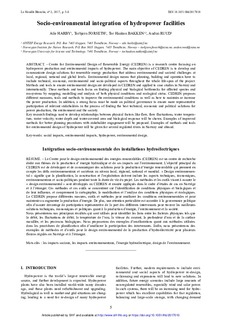| dc.contributor.author | Harby, Atle | |
| dc.contributor.author | Forseth, Torbjørn | |
| dc.contributor.author | Bakken, Tor Haakon | |
| dc.contributor.author | Ruud, Audun | |
| dc.date.accessioned | 2018-03-09T13:46:31Z | |
| dc.date.available | 2018-03-09T13:46:31Z | |
| dc.date.created | 2017-05-05T15:48:12Z | |
| dc.date.issued | 2017 | |
| dc.identifier.citation | La houille blanche. 2017, (2), 5-8. | nb_NO |
| dc.identifier.issn | 0018-6368 | |
| dc.identifier.uri | http://hdl.handle.net/11250/2489878 | |
| dc.description.abstract | Centre for Environmental Design of Renewable Energy (CEDREN) is a research centre focusing on hydropower production and environmental impacts of hydropower. The main objective of CEDREN is to develop and communicate design solutions for renewable energy production that address environmental and societal challenges at local, regional, national and global levels. Environmental design means that planning, building and operation have to include technical, economic, environmental and socio‑political aspects throughout the whole life‑span of the project. Methods and tools to ensure environmental design are developed in CEDREN and applied to case studies in Norway and internationally. These methods and tools focus on finding physical and biological bottlenecks for affected species and ecosystems by mapping, modelling and analysis of both physical conditions and ecological status. CEDREN proposes different measures, tools and methods to improve the environmental conditions as well as how to maintain or increase the power production. In addition, a strong focus must be made on political governance to ensure more representative participation of relevant stakeholders in the process of finding the best technical, economic and political solutions for power production, the environment and the society. Key research findings used to develop relationships between physical factors like flow, flow fluctuations, water temperature, water velocity, water depth and water‑covered area and biological response will be shown. Examples of improved methods for better planning procedures with stakeholder engagement will be proposed. Examples of methods and tools for environmental design of hydropower will be given for several regulated rivers in Norway and abroad. | nb_NO |
| dc.language.iso | eng | nb_NO |
| dc.rights | Navngivelse 4.0 Internasjonal | * |
| dc.rights.uri | http://creativecommons.org/licenses/by/4.0/deed.no | * |
| dc.title | Socio-environmental integration of hydropower facilities | nb_NO |
| dc.type | Journal article | nb_NO |
| dc.type | Peer reviewed | nb_NO |
| dc.description.version | Publisert versjon | nb_NO |
| dc.rights.holder | © Société Hydrotechnique de France, 2017 | nb_NO |
| dc.source.pagenumber | 5-8 | nb_NO |
| dc.source.journal | La houille blanche | nb_NO |
| dc.source.issue | 2 | nb_NO |
| dc.identifier.doi | 10.1051/lhb/2017010 | |
| dc.identifier.cristin | 1468510 | |
| dc.relation.project | Norges forskningsråd: 193818 | nb_NO |
| cristin.unitcode | 7548,50,0,0 | |
| cristin.unitname | Energisystemer | |
| cristin.ispublished | true | |
| cristin.fulltext | postprint | |
| cristin.qualitycode | 1 | |

